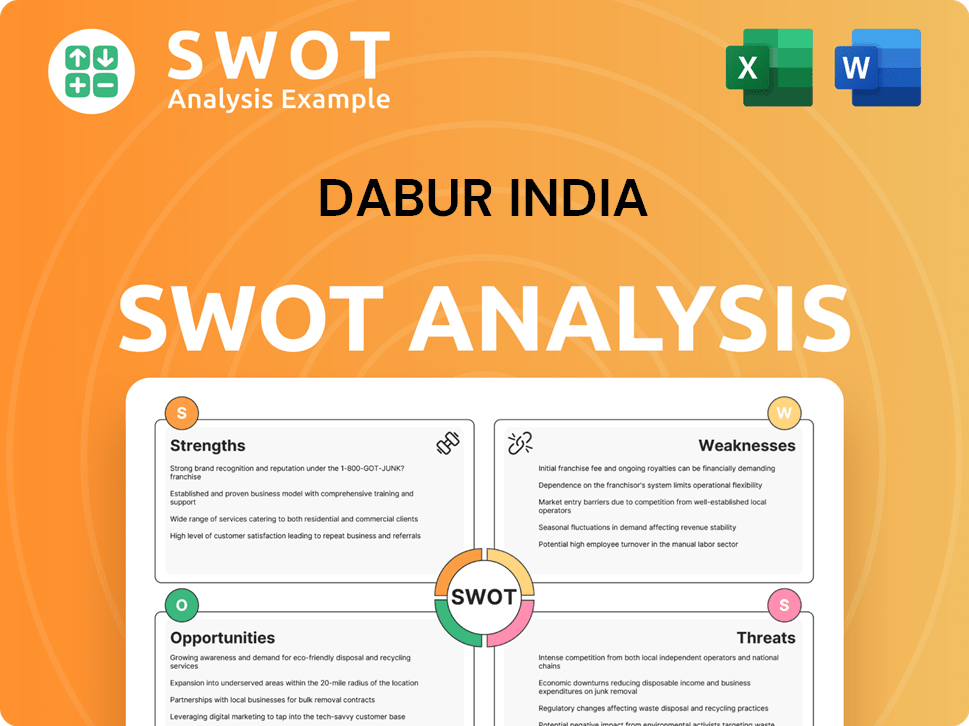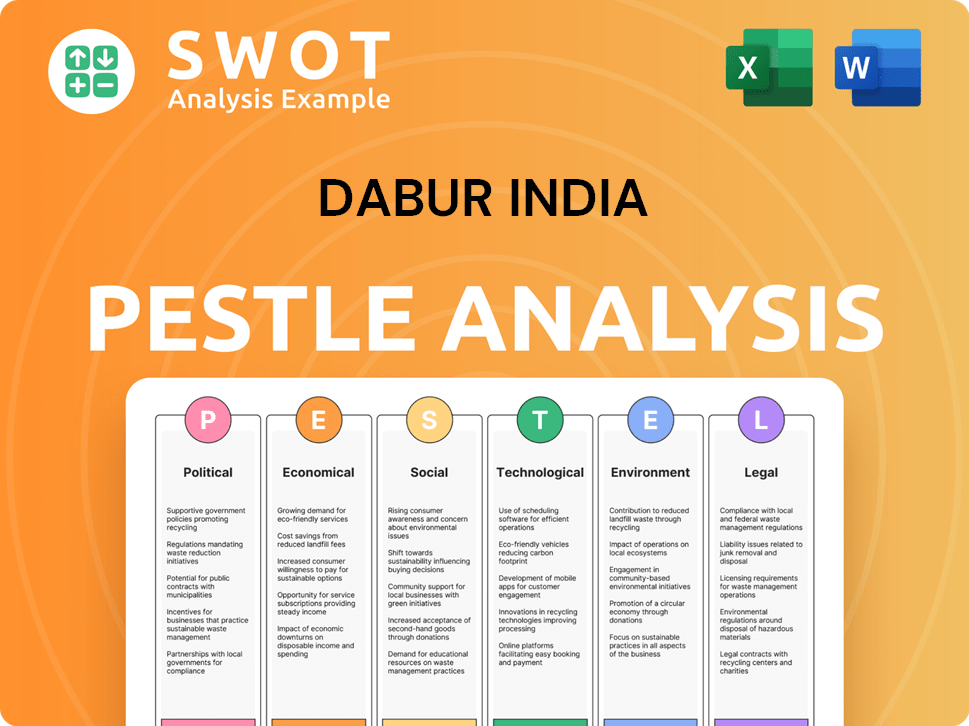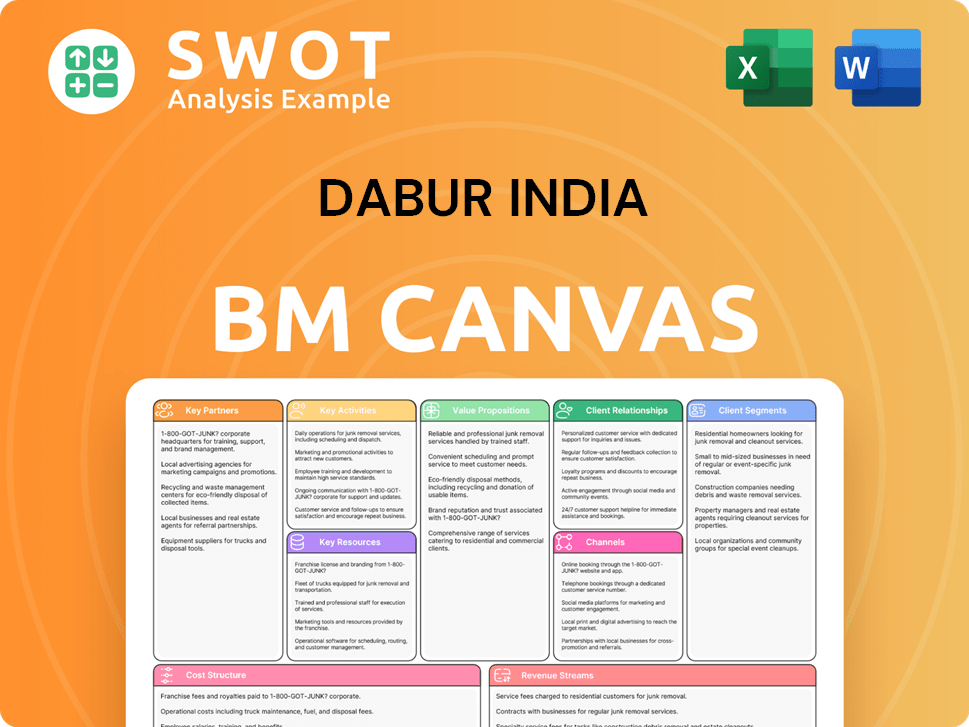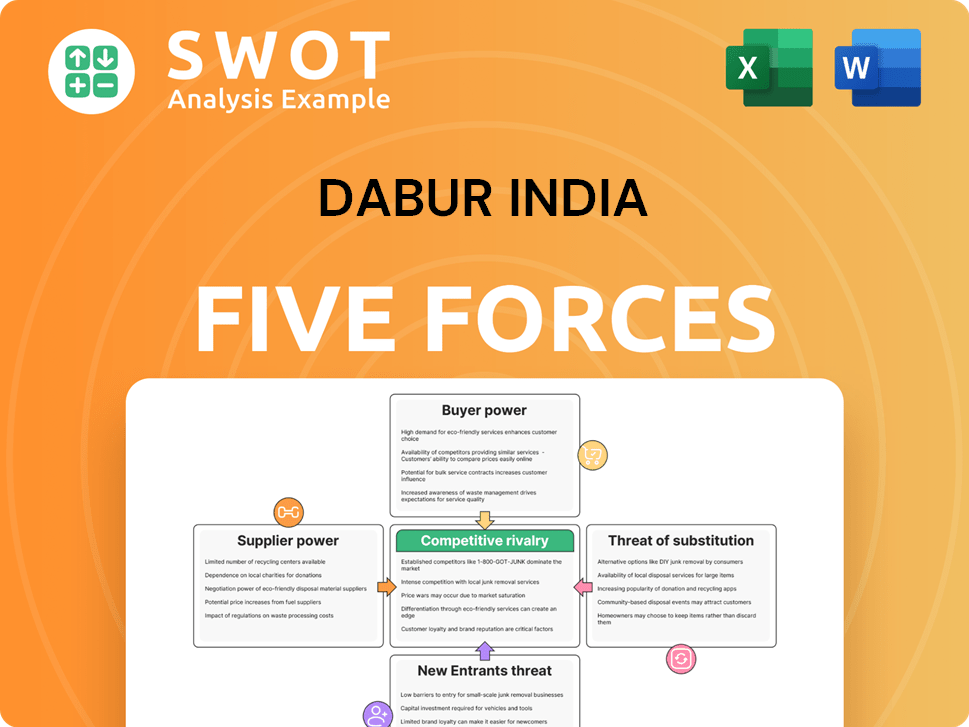Dabur India Bundle
How does Dabur India navigate the cutthroat FMCG arena?
The Indian Fast-Moving Consumer Goods (FMCG) sector is a dynamic market, predicted to hit $220 billion by 2025, and Dabur India Limited is a key player in this landscape. Founded in 1884, Dabur has evolved from Ayurvedic medicine to a diverse portfolio, including personal care and food products. This journey showcases its ability to adapt and thrive in a competitive environment.

Understanding the Dabur India SWOT Analysis is crucial for grasping its position within the FMCG industry. This report will delve into Dabur's competitive landscape, examining its market share, key competitors, and strategic advantages. We'll explore the market challenges and opportunities, providing a comprehensive market analysis to inform business strategy and investment decisions. This competitive intelligence will help you understand Dabur Company's future outlook and growth strategies.
Where Does Dabur India’ Stand in the Current Market?
Dabur India Limited holds a significant position within the Indian FMCG industry. As of the latest reports, it stands as the fourth-largest FMCG company in India. The company's core operations revolve around Ayurvedic and natural healthcare, personal care, and food products, catering to a broad consumer base across both urban and rural markets.
The company's value proposition lies in its diverse product portfolio, strong brand recognition, and extensive distribution network. Dabur focuses on providing quality products that resonate with consumer preferences for natural and herbal solutions. This strategy has enabled Dabur to maintain a competitive edge and sustain its market share in a dynamic industry.
Dabur's revenue for the financial year ending March 31, 2025, was approximately $1.6 billion (₹13,113.19 crore), reflecting a 1.75% increase from the previous year. As of July 2024, Dabur's market share in India was reported at 15.8%. This market share underscores the company's strong presence and consumer trust in its diverse product range.
Dabur maintains leadership positions in specific segments. It holds over 40% market share in branded honey and over 65% in Dabur Chyawanprash. Additionally, Dabur commands a 90% market share in herbal digestives, with Hajmola leading the digestive tablets category at 75% market share. These figures highlight Dabur's dominance in key product categories.
Dabur's product portfolio includes hair care (Dabur Amla, Vatika), oral care (Dabur Red Toothpaste), health supplements (Dabur Chyawanprash, Dabur Honey), digestive aids (Hajmola), and fruit juices (Real). The company's diverse range of products caters to a wide array of consumer needs. The brand's strong presence is built on the foundation of trust and quality.
Dabur's products are available in over 120 countries globally, with manufacturing facilities in 8 countries outside India. Domestically, Dabur's distribution network covers over 7.9 million retail outlets and reaches 122,000 villages as of FY24. This extensive network ensures product availability and market penetration.
Dabur's strategic focus includes expanding its rural footprint and embracing digital transformation. The company has increased its rural reach to 122,000 villages in 2023. Dabur's home and personal care segment accounted for 48.6% of its India FMCG business in 2023-24 and reported an 8.1% growth. For a deeper understanding of Dabur's financial structure and revenue streams, you can explore the Revenue Streams & Business Model of Dabur India.
While Dabur's net profit for FY25 declined by 4.1% to ₹17.7 billion from FY24, and its profit margin decreased to 14% from 15% due to higher expenses, its strategic investments in distribution and brand-building aim to improve profitability and market reach. Despite a challenging operating environment in Q4 FY25, Dabur reported a 2.1% constant currency revenue growth, with its international business achieving a 19% growth in constant currency terms.
- The company faces challenges such as increased expenses.
- Dabur is investing in distribution and brand-building.
- International business shows strong growth.
- The company is adapting to changing market dynamics.
Dabur India SWOT Analysis
- Complete SWOT Breakdown
- Fully Customizable
- Editable in Excel & Word
- Professional Formatting
- Investor-Ready Format

Who Are the Main Competitors Challenging Dabur India?
The Dabur India faces a dynamic and intensely competitive environment within the Fast-Moving Consumer Goods (FMCG) sector. Understanding its competitive landscape is crucial for assessing its market position and future prospects. This involves analyzing the key players, their strategies, and the overall market dynamics that influence Dabur Company's performance.
Market Analysis reveals that Dabur India's success hinges on its ability to navigate the challenges posed by both multinational corporations and strong domestic rivals. A detailed examination of these competitors is essential for formulating effective business strategies and maintaining a competitive edge. The FMCG industry's evolving nature necessitates continuous adaptation and innovation to stay ahead.
Hindustan Unilever (HUL) is a major multinational competitor, operating across various FMCG categories. HUL's substantial marketing budgets and aggressive strategies pose a significant challenge to Dabur's market share and margins. HUL has been investing heavily in digital transformation, AI, and IoT to enhance operational efficiency.
ITC Limited competes with Dabur in segments like packaged foods, personal care, and agarbattis. ITC's extensive distribution network and strong brand presence make it a key rival. ITC's diversified portfolio and strong market presence contribute to intense competition.
Marico is a strong competitor in hair care and edible oils, with brands like Parachute and Saffola. Marico's focus on specific product categories and market leadership in those segments directly challenge Dabur's hair oil portfolio. Marico's strategic focus enhances its competitive position.
Emami Limited has a strong presence in personal care and healthcare, particularly in Ayurvedic and natural products. Emami directly competes with Dabur's core offerings in this space. Emami's focus on Ayurvedic products aligns closely with Dabur's strengths.
Colgate-Palmolive is a dominant player in the oral care segment, presenting intense competition for Dabur's oral care brands. Colgate-Palmolive's strong brand recognition and market share create significant competitive pressure. Colgate-Palmolive's marketing strategies are a key factor.
Patanjali Ayurved has rapidly gained market share by emphasizing Ayurvedic and natural products. This directly aligns with Dabur's foundational strengths, creating a high-profile rivalry. Patanjali's aggressive pricing and nationalist appeal have influenced market dynamics.
New and emerging players, especially those leveraging e-commerce and direct-to-consumer (DTC) models, are disrupting the traditional competitive landscape. Quick commerce platforms are changing consumer expectations, offering faster product access, which impacts traditional distribution models. For further insights, you can explore the Growth Strategy of Dabur India. Mergers and alliances can significantly alter competitive dynamics by consolidating market power or creating new distribution synergies. This includes understanding Dabur India's market share analysis, Dabur India competitors SWOT analysis, and Dabur India product portfolio review. Also, consider Dabur India financial performance, Dabur India competitive advantages, and Dabur India market challenges. Analyzing Dabur India key competitors and the Dabur India industry analysis report is vital. Examine Dabur India growth strategies, Dabur India consumer behavior, and Dabur India brand positioning. Consider Dabur India recent acquisitions, Dabur India distribution network, and Dabur India future outlook. Finally, Dabur India competitive intelligence is crucial.
Dabur India PESTLE Analysis
- Covers All 6 PESTLE Categories
- No Research Needed – Save Hours of Work
- Built by Experts, Trusted by Consultants
- Instant Download, Ready to Use
- 100% Editable, Fully Customizable

What Gives Dabur India a Competitive Edge Over Its Rivals?
As a prominent player in the FMCG industry, understanding the competitive landscape of Dabur India is crucial for investors and strategists alike. This analysis delves into the company's competitive advantages, providing insights into its market position and strategic strengths. The following sections will explore the key factors that contribute to Dabur's success, offering a comprehensive view of its operational and market dynamics.
Dabur India's journey, marked by significant milestones and strategic moves, has shaped its competitive edge in the market. From its inception, the company has focused on leveraging its heritage and expertise in Ayurveda to build a robust brand. Recent strategic initiatives include expanding its product portfolio and strengthening its distribution network, which are aimed at enhancing its market share and customer reach. This proactive approach underscores Dabur's commitment to sustainable growth and market leadership.
The company's competitive advantages are multifaceted, stemming from its strong brand equity, diverse product offerings, and extensive distribution capabilities. These strengths are further enhanced by its focus on innovation and consumer-centric solutions, positioning it favorably in a competitive market. To understand the company's position, this analysis will explore the core elements that define Dabur's competitive landscape.
Dabur's strong brand equity is a key competitive advantage, built over a legacy of over 140 years. This heritage has cultivated immense consumer trust, especially in the Ayurvedic and natural products sector. With a brand recall of approximately 73%, Dabur commands competitive pricing for its established products, reinforcing its market position.
The company boasts a diverse portfolio of over 250 herbal and Ayurvedic products, spanning healthcare, personal care, home care, and food segments. This diversification reduces dependence on any single product category. Iconic products like Dabur Chyawanprash and Dabur Honey have become household staples, demonstrating the company's ability to innovate and expand its offerings.
Dabur has one of the most extensive distribution networks in the Indian FMCG industry. As of FY24, its products reach over 7.9 million retail outlets and 122,000 villages across India. This reach is supported by 14 manufacturing units and 2 Mother Warehouses and 26 Carrying and Forwarding Agents (CFAs) in India, ensuring efficient product availability.
The company's deep-rooted expertise in Ayurveda provides a unique competitive edge. The company continually researches and develops new products, combining ancient Ayurvedic wisdom with modern science. This focus on natural and herbal ingredients resonates with the growing consumer preference for health and wellness products.
Dabur's well-established and efficient supply chain is another key advantage. It operates 13 plants across India and 45 contract manufacturing locations. The company uses technology like SAP to monitor product movement and ensure availability, which helps minimize stock-outs and increase efficiency. This commitment to quality and safety strengthens its operational excellence.
- The company's focus on consumer-centric solutions and strategic partnerships aims to sustain these advantages in a rapidly evolving market.
- Dabur's ability to innovate and adapt to changing consumer preferences is crucial for maintaining its competitive edge.
- The company faces threats from new entrants and aggressive marketing by rivals, which necessitates continuous strategic adjustments.
- Dabur's ongoing investments in brand-building and product innovation are essential for long-term success.
Dabur India Business Model Canvas
- Complete 9-Block Business Model Canvas
- Effortlessly Communicate Your Business Strategy
- Investor-Ready BMC Format
- 100% Editable and Customizable
- Clear and Structured Layout

What Industry Trends Are Reshaping Dabur India’s Competitive Landscape?
The Indian Fast-Moving Consumer Goods (FMCG) sector is experiencing significant shifts, influenced by technology, consumer preferences, and market dynamics. This environment presents both challenges and opportunities for companies like Dabur India. Understanding the Dabur Company's position within this evolving landscape is crucial for making informed investment decisions and developing effective business strategies.
As the sector transforms, Dabur India must navigate increasing competition and adapt to changing consumer demands. This involves leveraging its strengths in the health and wellness space while addressing challenges like fluctuating raw material costs and evolving regulatory landscapes. Comprehensive market analysis and strategic planning are essential for sustained growth and success in this dynamic environment. For more information, check out Owners & Shareholders of Dabur India.
The FMCG sector is seeing rapid growth in e-commerce, with an expected CAGR of 27% from 2021 to 2026. Consumers are increasingly focused on health, wellness, and sustainability, favoring natural products. Rural markets are showing stronger volume growth compared to urban areas, presenting a key area for expansion.
Intense competition from multinational corporations with large marketing budgets is a constant challenge. Fluctuations in raw material prices, particularly those of natural ingredients, can impact profitability. A weak FY25, with a projected decline in domestic FMCG and operating margin contraction, poses near-term hurdles.
Expanding into emerging markets and international territories offers significant growth potential. Innovation in the wellness and personal care segments, along with strategic partnerships, can drive further expansion. The anticipated recovery in urban demand, combined with continued rural growth, provides a positive outlook.
Dabur India's competitive position is expected to evolve by leveraging its Ayurvedic heritage and expanding market reach. The company is focused on brand support, enhanced go-to-market strategies, and increasing operational efficiency. Synergistic acquisitions are also being explored to increase market share.
Dabur India is focusing on several key strategies to navigate the changing market and achieve its growth targets. These strategies include leveraging its core strengths in the Ayurvedic and health and wellness categories, expanding its distribution network, and investing in brand building to enhance consumer loyalty.
- Focus on Power Brands: Strengthening the power brands to drive growth and market share.
- New Product Launches: Continuously launching new products to meet evolving consumer preferences.
- Distribution Expansion: Expanding the distribution infrastructure to reach a wider consumer base.
- Digital Engagement: Enhancing digital engagement and e-commerce capabilities.
Dabur India Porter's Five Forces Analysis
- Covers All 5 Competitive Forces in Detail
- Structured for Consultants, Students, and Founders
- 100% Editable in Microsoft Word & Excel
- Instant Digital Download – Use Immediately
- Compatible with Mac & PC – Fully Unlocked

Related Blogs
- What are Mission Vision & Core Values of Dabur India Company?
- What is Growth Strategy and Future Prospects of Dabur India Company?
- How Does Dabur India Company Work?
- What is Sales and Marketing Strategy of Dabur India Company?
- What is Brief History of Dabur India Company?
- Who Owns Dabur India Company?
- What is Customer Demographics and Target Market of Dabur India Company?
Disclaimer
All information, articles, and product details provided on this website are for general informational and educational purposes only. We do not claim any ownership over, nor do we intend to infringe upon, any trademarks, copyrights, logos, brand names, or other intellectual property mentioned or depicted on this site. Such intellectual property remains the property of its respective owners, and any references here are made solely for identification or informational purposes, without implying any affiliation, endorsement, or partnership.
We make no representations or warranties, express or implied, regarding the accuracy, completeness, or suitability of any content or products presented. Nothing on this website should be construed as legal, tax, investment, financial, medical, or other professional advice. In addition, no part of this site—including articles or product references—constitutes a solicitation, recommendation, endorsement, advertisement, or offer to buy or sell any securities, franchises, or other financial instruments, particularly in jurisdictions where such activity would be unlawful.
All content is of a general nature and may not address the specific circumstances of any individual or entity. It is not a substitute for professional advice or services. Any actions you take based on the information provided here are strictly at your own risk. You accept full responsibility for any decisions or outcomes arising from your use of this website and agree to release us from any liability in connection with your use of, or reliance upon, the content or products found herein.